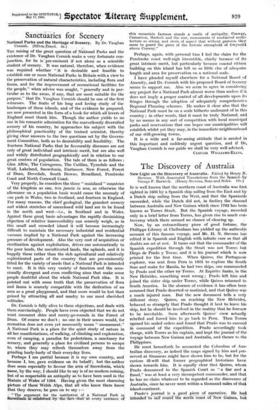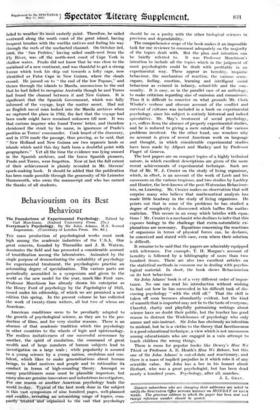The Discovery of Australia
IT is well known that the northern coast of Australia was first sighted in 1606 by a Spanish ship sailing from the East and liy a Dutch ship sailing from the West, and that the Spaniatis succeeded, while the Dutch did not, in finding the channel between Australia and New Guinea which since 1762 has been known as Torres Strait. But the Spanish voyage, recorded only in a brief letter from Torres, has given rise to much con- troversy which there seemed no chance of clearing up.
Now, by an extraordinary piece of good fortune, the Phillipps Library at Cheltenham has yielded up the authentic account of this famous voyage, and Mr. H. N. Stevens luis edited it in Spanish and English with infinite care so that all doubts are set at rest. It turns out that the commander of the Spanish expedition through the Strait was not Torres but Diego de Prado y Toyer, and it is his journal which is now printed for the first time. When Quiros, the Portuguese explorer, was sent from Peru in 1605 to explore the South Seas and make for Manila, he had two ships, one commanded by Prado and the other by Torres. At Espiritu Santo, in the New Hebrides, something went wrong ; Prado left him and joined the sister ship under Torres, while Quiros returned to South America. In the absence of evidence it has often been assumed that Prado deserted or mutinied, and that Quiros was a much injured man. But the new document tells a very different story. Quiros, on reaching the New Hebrides, behaved so strangely that Prado thought it best to leave his ship, lest he should be involved in the mutiny that he foresaw to be inevitable. Soon afterwards Quiros' crew actually rebelled and forced him to go back to Peru. Then Torres opened his sealed orders and found that Prado was to succeed in command of the expedition. Prado accordingly took charge, with Torres as his captain, and kept the journal of the voyage between New Guinea and Australia, and thence to the Philippines.
• He must henceforth be accounted the Columbus of Aus- tralian discovery, as indeed the maps signed by him and pre- served at Simancas might have shown him to be, but for the curious ill-will that former geographical historians have Shown towards hitn. It is equally clear that Quiros, whom Prado denounced to the Spanish Court as " a liar and a fraud," was at least a very incompetent commander, and that he has no claim whatever to be regarded as the discoverer of Australia, since he never went within a thousand miles of that island-continent.
Prado's journal is a good piece of narrative. He had -oTNew Guinea, bia failed to weathereits'lliolt easterly point. Therefore, he sailed westward along the south coast of the great island, having frequent brushes with the warlike natives-and feeling his way through the reefs of the uncharted channel.- Oft October 3rd, 1606, the San Pedrico,' having sailed south-west from the Fly River; Wig . off :the north-west coast of Cape York in shallow water. Prado did not know that he was close to the mainland of a new continent, and was thankful to get a strong breeze which took his ship out towards a lofty cape, now identified as, False -Cape in - New Guinea, where the shoals ceased. He passed on to the end of the low Papuas," and thence through the islands to Manila, unconscious to the end that he had failed to recognize Australia though 'he:and Torres had found the channel betWeen it - and New Guinea. It is significant that the Spanish Government, which was fully informed of the voyage, . kept the matter secret. Had not an English naval man -looked into .the Manila archives when we captured the place in 1762, the fact that the voyage had been made might have remained unknown till now. It was that curious inquirer who found Torres' letter, and therefore christened the strait by his name, in ignorance of Prado's position as Torres' commander. Cook heard of the discovery, and in 1770 made the passage, thus proving, as he said, that `.` New Holland and New Guinea are two separate lands or islands which until this day hath been a doubtful point with geographers." Yet all the time the evidence was lying unused in the Spanish archives, and the brave Spanish pioneers, Prado and Torres, were forgotten. Now at last the full extent Of their achievement' is plainly revealed in Mr. Stevens' epoch-making book. It should be added that the publication has been made possible through the generosity of Sir Leicester Harmsworth, who owns the manuscript and who has earned the thanks of -all students.















































 Previous page
Previous page